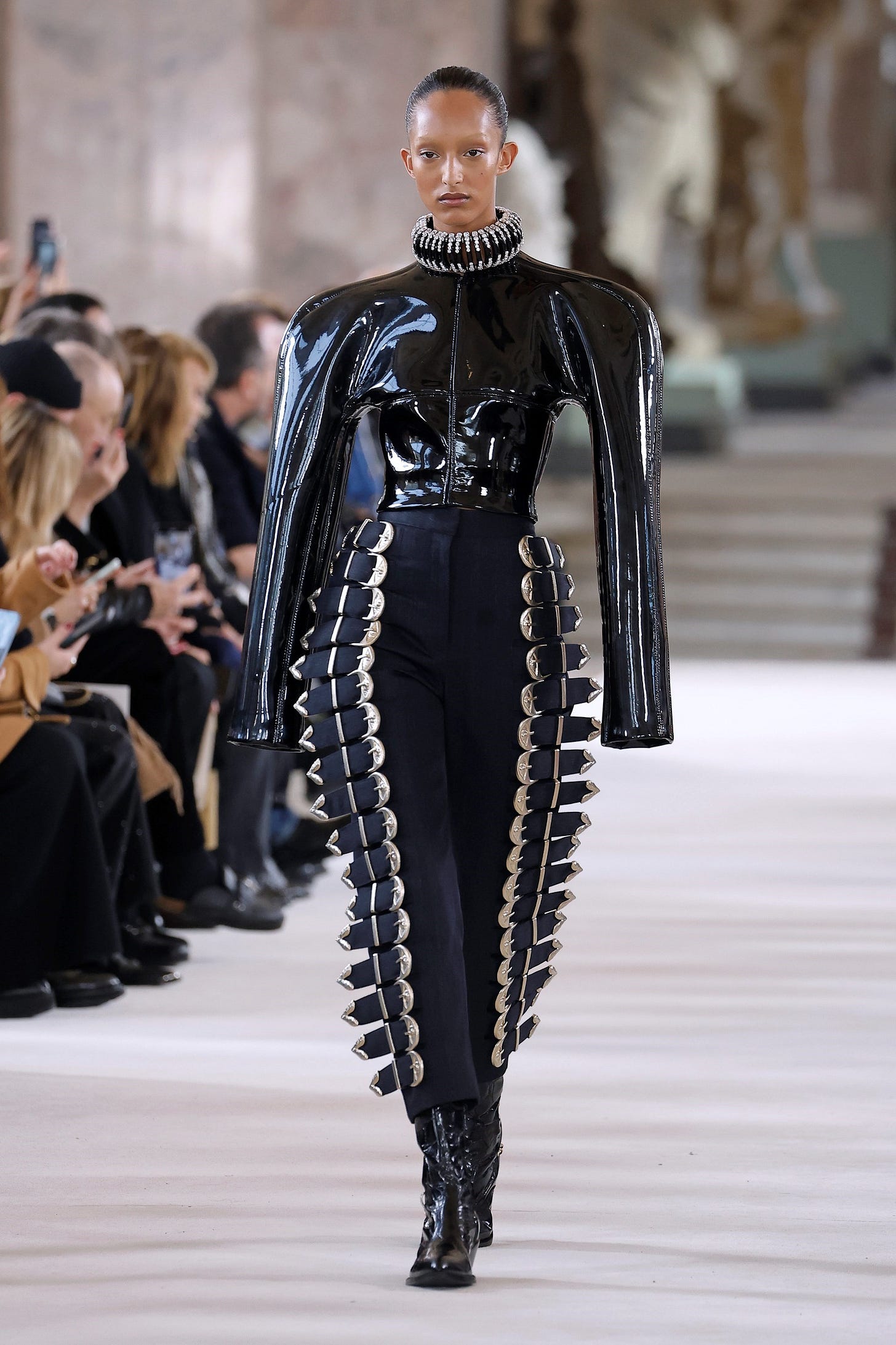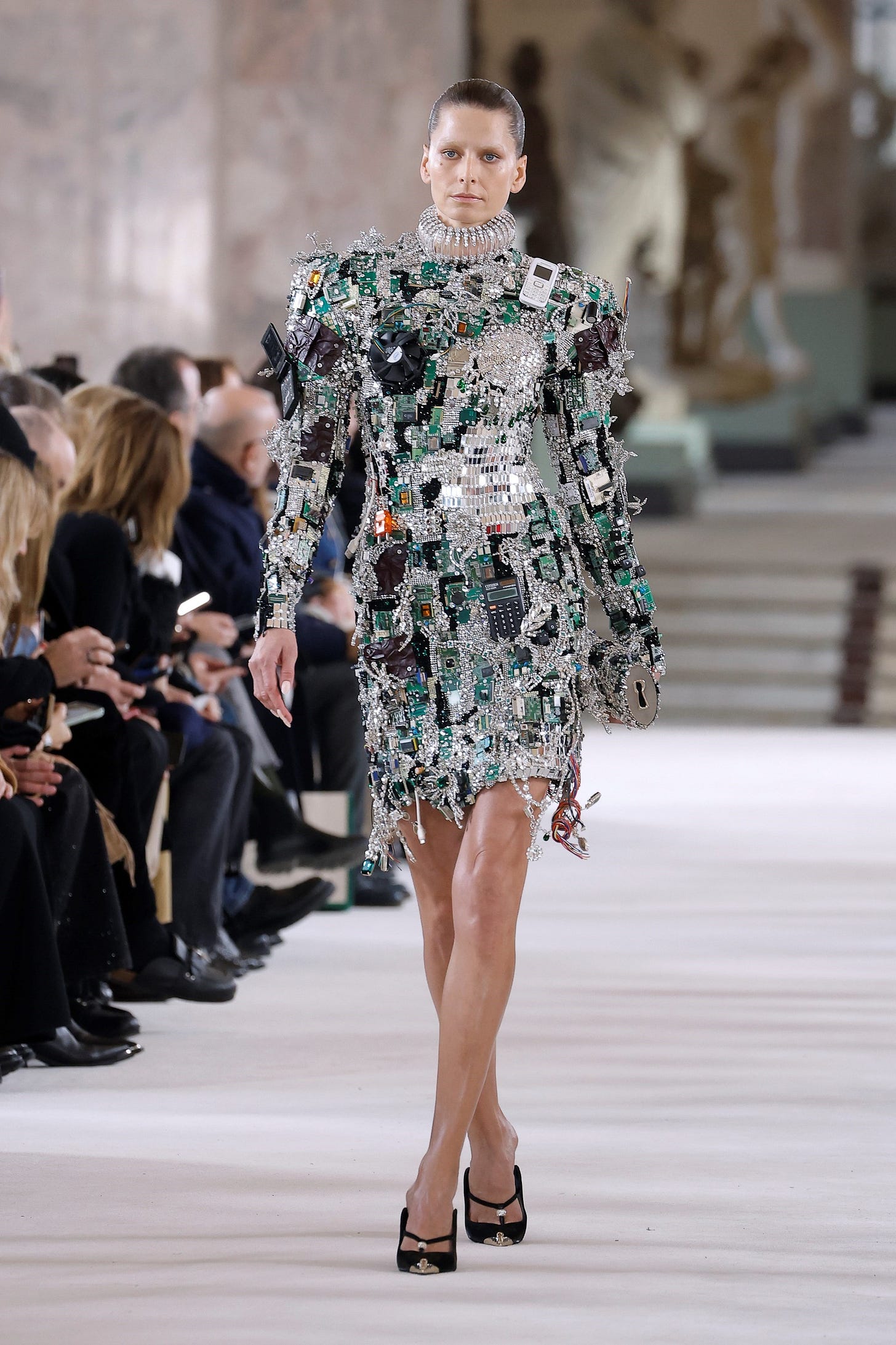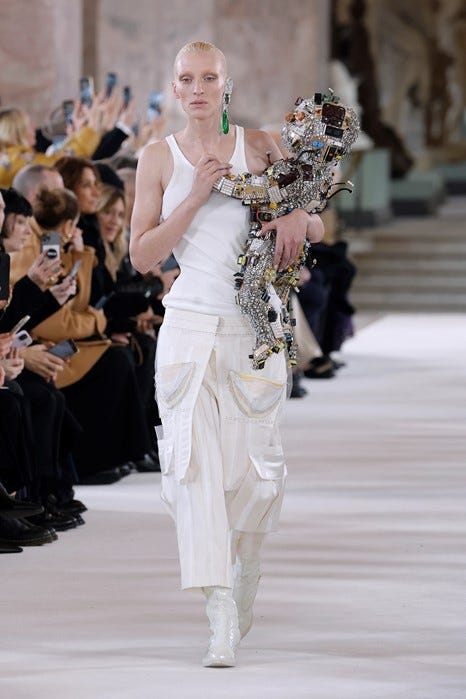keep fashion weird - schiaparelli’s SS24
thrift to the bottom of the earth and convince yourself that the 3-euro pile holds all the secrets to slay
Inside me there are two wolves: one views overconsumption as proof of our moral and cultural decline; the other loves couture.
Schiaparelli’s SS24 show on Monday was sound-tracked to ‘Top Gun.’ Its designs were stitched together with screens and intertextual references to movies (Oppenheimer, Alien, and Jupiter). The looks themselves are gorgeous. Out-of-this-world. Schiaparelli’s colour palette is what you may find at an electronic wasteland: latex black; metallic grey; battery green. It is also what you may find at a fantasy convention: cream puff sleeves; medieval-style collars; shoulder-padded suits. The silhouettes are not just dramatic, they are sentient beings themselves, extending models’ bodies into metaphors of more.
Special shoutout to the looks, ‘Mother,’ and the model carrying ‘Baby.’ These are made of what Creative Director David Roseberry calls “pre-historic technology” (which he defines as “pre-2007”). David uses Swarovski crystals and electronic chips to pay homage to a past before Steve Jobs and a present that misses flip phones. Clunky technology becomes obsolete because of minimalism, and then its clunkiness becomes an aesthetic as tender as a memory. Yeah. Mother is mothering.
David is good. He is bringing Schiaparelli back, by going back to Sciaparelli’s roots: the avant-garde, the surreal, the outlandish, the outrageous.
Elsa Schiaparelli, founder of the Maison, was an Italian misfit from high society who wrote scandalous poetry while studying philosophy in Rome. As a result of said poetry, her family sent her to a convent. In protest of said convent, she went on a hunger strike. And then, as all the best stories go, she found herself in 1920s Paris.
After a surprise patronage from the man behind Galaries Lafayette, her double-stitched sweaters first gained attention. They were, decidedly, weird. (Please note the bow.)
Over the next 20 years, she worked and hung out with the best of the bunch - Man Ray, Duchamp, Picasso, Warhol, Dali, and Cocteau. She considered clothing art. Elsa invented my personal favourite article of attire – the skort. She also (and this is something we should really be trying to bring back) made gloves on which you could actually light a match. That’s just plain cunty. Yves Saint Laurent, years later, said about her impact: “She slapped Paris. She smacked it. She tortured it. She bewitched it. And it fell madly in love with her.”
I like haute couture because it does not ask what fashion can do for your body, but what your body can do for fashion. It is not interested in being flattering, or form-fitting. It is most disinterested in whether you are a spring or an autumn, a silver girl or a gold girl. Thank god for that. Aren’t we tired of suiting ourselves? Aren’t we sick of treating our bodies like finished paintings looking for a frame, instead of blank canvases and unmolded clay?
I stopped buying fast fashion about 6 years ago. I had done my research. Sweat-shops/factories were collapsing – that is, when they weren’t burning women workers on fire. Zara’s ‘employees’ stitched SOS-calls into their clothes. Overconsumption was creating plastic islands in the ocean. I hated haul culture, and I hated Shein. For any of my feminism and socialism to stick, I knew I couldn’t patronize these stores.
(To be clear, luxury brands also suck in this regard. Despite their ridiculous prices, houses like Dior, LV, St. Laurent, Burberry etc. enlist labourers under devastating conditions. Underpaid embroiders from India make Dior’s skirts and 950$ t-shirts that say ‘We Should All Be Feminists,’ and ‘” Femininity, the trap”- Simone de Beauvoir.’ But since I want to talk today about style, and not about how there is no ethical consumption under capitalism, I’ll keep it moving – rest assured, I didn’t give up fast fashion for luxury fashion.)
It wasn’t that hard to cut fast fashion out of my life. I’d always loved shopping, but nothing in H&M or Zara could be considered ‘style.’ All was boring trends made more boring by their short life-span, and the inevitable fact that everybody else would be wearing the same thing. There was no struggle, no search, no gift of discovering what spoke to your inner eye in these massive corporations. And this was before TikTok trends ruled over us all with a bow-wrapped iron fist.
Indeed, ever since I watched that fateful TikTok – “use 3 words to define your personal style,” the horizon of outfits I wore shrunk. (To those who know me, so did my general self-confidence and spunk). My sartorial pickings had to be classy, neutral, sophisticated, and elegant. I became a poster-girl for mock necks, sweater vests, and white linen pants with white linen shirts tucked into them. I began to dress like I was afraid of my body. A series of rules racked my closet: no cleavage; no shorts that made my thighs look bad; no t-shirts with stupid words on them. Sure, this desire for timelessness protected me from dressing like the hype-girls of sneakerhead-land and the cut-up queens of y2k gone 2 far. But the only joys I was getting from clothes were coming from the richness of the fabric, their fall on my frame, and the way they’d look in pixel. Where was trashy, weird, and downright deranged? Well-matched outfits rarely make history.
Couture – especially when done with as much aplomb as Schiaparelli – is about this beautiful weirdness. Yes, its price tags are inaccessible. Yet, unlike the beige prison of ‘quiet luxury,’ couture reminds me that fashion is about art and expression and scandal and fun. It is not about monochromes and pastels that are supposed to help you class-signal better. Forget coastal-grandmother-loro-piana-ralph-lauren-core. Ditch the pearls and clutch the campy. Be ugly. Thrift to the bottom of the earth and convince yourself that the 3-euro pile holds all the secrets to slay.
When Elsa Schiaparelli was coming up in the world, she was placed against the other titan of the time, Madame Coco Chanel. Chanel’s sweaters were so well-stitched they looked factory-made in their perfection. Her suits were clean, and her women were ladies. Schiaparelli, on the other hand, was more interested in ideas, and in invention. Because her stitching wasn’t perfect, she clipped fabric together with strange broaches and random buttons. Then, she turned those broaches and buttons into insects and animals. She painted gold fingernails on black evening gloves. She took René Magritte’s ‘Ceci n’est pas une pipe’ and turned the pipe into a bottle for men’s cologne. Salvador Dali’s clock was turned into a woman’s powder compact. Needless to say, the two women did not get along.
I love Chanel as much as the next god-fearing-Blair Waldorf-loving girl. At the same time, I am tired of dressing to code cool and classy and effortless. I am, in fact, none of those things. I want colour and cloth to leap off my body with audacity and artfulness and personality. I might, at first, feel more anxious and perceived when my clothes make me stand out in a room. But with time, these outfits will make me feel bigger and weirder - and more comfortable with being both.
“In difficult times, fashion is always outrageous.” -Elsa Schiaparelli









